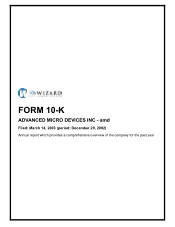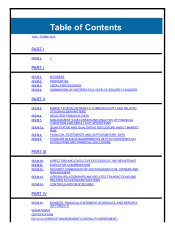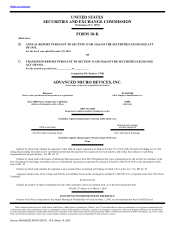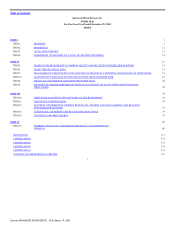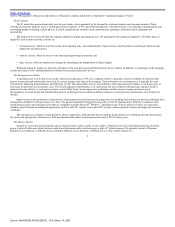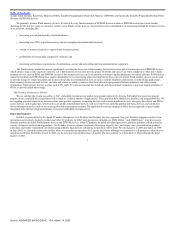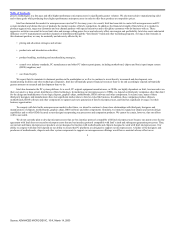AMD 2002 Annual Report Download - page 9
Download and view the complete annual report
Please find page 9 of the 2002 AMD annual report below. You can navigate through the pages in the report by either clicking on the pages listed below, or by using the keyword search tool below to find specific information within the annual report.
Table of Contents
Core Products
Our Core Products segment ($2.663 billion, or 99 percent, of our 2002 net sales) includes microprocessor, memory and other IC products.
PC Processors
In 2002, most of our microprocessor product sales were from our seventh-generation x86 Microsoft Windows® compatible AMD Athlon and AMD Duron
microprocessors. We based AMD Athlon and AMD Duron microprocessors on superscalar RISC, or reduced instruction set computer, architecture. RISC
architecture allows microprocessors to perform fewer types of computer instructions thereby allowing the microprocessor to operate at a higher speed. We also
designed our AMD Athlon and AMD Duron microprocessors to be compatible with operating system software such as Windows XP, Windows 2000, Windows
NT®, Windows 98 (and Windows predecessor operating systems), Linux, NetWare ® and UNIX.
Historically, each generation of x86 microprocessors has improved both in terms of architectural performance or instructions per clock cycle, and
frequency, also referred to as “clock speed.” In October 2001, we introduced the AMD Athlon XP processor for high performance desktop computers. The AMD
Athlon XP processor family features QuantiSpeed™ architecture for rapid execution of applications and 3DNow!™ Professional technology to enhance digital
multimedia performance. With the introduction of the AMD Athlon XP processor, we began positioning our processors based on overall performance, which is a
function of both architecture and frequency measured in megahertz. We believe overall performance is a better indicator of CPU capability than simply raw
megahertz or clock speed. Since frequency cannot be solely relied upon as a measure of system performance, we quantify our overall performance in terms of
model numbers to position our products against comparable Intel products designated only by their clock speed.
We currently offer products for the desktop PC, mobile computing, server and workstation markets. Our x86 microprocessors for the desktop PC market
consist of the AMD Athlon XP processor and the AMD Duron processor. Our x86 microprocessors for the mobile computing market consist of the mobile AMD
Athlon XP, the mobile AMD Athlon 4 and the mobile AMD Duron processors. Our AMD Athlon MP products focus on the server and workstation markets.
We plan to begin shipping our eighth-generation microprocessors in 2003. These processors include AMD Opteron ™ processors for the server and
workstation markets, which we plan to introduce in April 2003, and AMD Athlon 64 processors for the desktop and mobile markets, which we plan to introduce
in September 2003. These processors are 64-bit processors that are fully compatible with, and increase the performance of, existing 32-bit software. These
processors support HyperTransport technology, which is a high bandwidth communications interface we invented, and have integrated memory controllers that
enable substantially higher performance than existing, non-integrated memory controller architectures. We expect our advanced architecture to provide users
with even greater performance improvements as operating systems and software applications begin leveraging the benefits of our 64-bit architecture. To that end,
we announced in April 2002 that we are collaborating with Microsoft to incorporate 64-bit support for our AMD Opteron and AMD Athlon 64 processors in the
Windows operating system. We believe that the backward compatibility of these processors will allow migration from current 32-bit operating systems and
applications to future 64-bit operating systems and applications on a common hardware platform.
Increasing microprocessor product revenues in 2003 depends on our ability to maintain or increase average selling prices for our microprocessors, growth
in unit shipments of our PC processors, our ability to introduce in a timely manner and achieve market acceptance for our AMD Opteron and AMD Athlon 64
processors and increasing market acceptance of the newest versions of the AMD Athlon microprocessors.
The microprocessor market is characterized by short product life cycles and migration to ever-higher performance microprocessors. To compete
successfully against Intel in this market, we must transition to new
4
Source: ADVANCED MICRO DEVIC, 10-K, March 14, 2003

